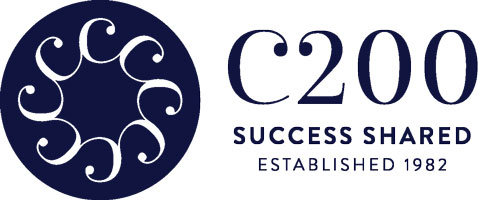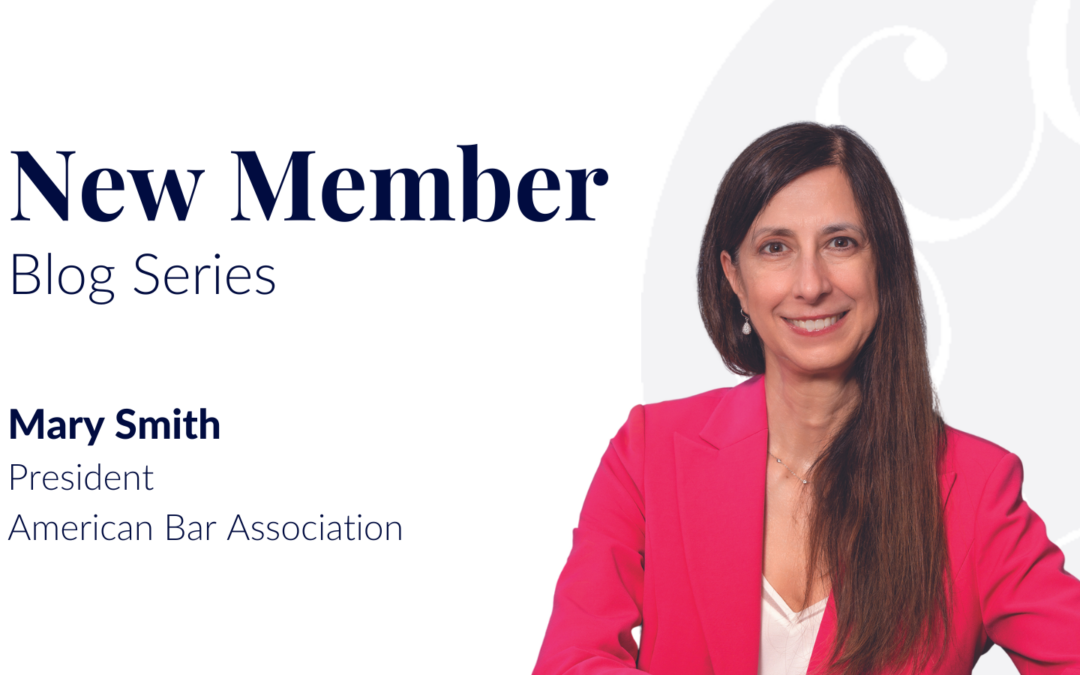
by Eva Glassman | Mar 5, 2024 | Blog, Featured
Mary Smith is Co-CEO of the Tribal Abatement Fund Trust, managing over $1 billion in settlement funds to address the opioid crisis in the United States, particularly in Native American communities. She is also President of the American Bar Association and is the first Native American woman to hold the position. Mary’s undergraduate degree was in mathematics and computer science, but she ended up with a career in public service due to her passion for helping others. Outside of work, she enjoys traveling and is inspired by meeting new people. Mary has been a member of C200 since September 2023.
Eva Glassman: Can you please describe your work? What industry do you work in?
Mary Smith: I am the president of the American Bar Association, the largest voluntary Bar Association in the world, and am the first Native American woman to hold this position. I serve as an independent director of a global biopharmaceutical company, PTC Therapeutics. I am also Vice Chair of the VENG Group, a national consulting firm that offers multidisciplinary and technologically driven approaches to problem solving. Finally, I also serve as Co-CEO of the Tribal Abatement Fund Trust, overseeing the distribution of $1.5 billion worth of opioid settlements to Native American tribes across the country.
EG: That is incredible work, and so is the rest of your career journey—you’ve worked in the White House! What I find most interesting is your educational background in technology, math, and engineering. How did you end up in law?
MS: I actually didn’t grow up wanting to be a lawyer, nor did I imagine devoting much in my career to public service. I grew up in a family where neither of my parents went to college. My dad quit high school to join the Navy during World War II. My mother was a gifted student who graduated high school when she was 16, but she did not attend college even though her three brothers did. I know I’m biased, but I think my mom was smarter than all her brothers. She didn’t go to college because it was a time when girls really didn’t do that.
My undergraduate degree was mathematics and computer science. I enjoyed all subjects, but I majored in mathematics and computer science because I knew that I would be able to have a career in that field. I worked as a systems programmer for a few years after college. The part of my job that I enjoyed the most was helping people with computer problems. I realized that I wanted to help people in broader ways, and that is when I thought about going to law school.
After working as an attorney at the US Department of Justice for a few years, I became fascinated with politics and public service, so I offered to volunteer on a presidential campaign. I sent a letter saying that I would quit my job to volunteer full time for the campaign, and I was offered a position.
I subsequently was very fortunate and honored to get a position in the White House to work on policy issues like equal pay for women, domestic violence and sexual assault, homelessness, civil rights issues, Native American issues, and consumer issues. After the White House, I worked at a Fortune 200 company in a senior role and also worked in a senior role in a gubernatorial administration in Illinois.
Later, I was offered the position of being CEO of the Indian Health Service, a $6 billion agency with more than 15,000 employees that provides healthcare to over 2 million Native Americans around the country. Part of the reason I took the position was to honor my Native American grandmother who grew up in a family of 16 children, only 10 of whom lived above the age of three due to lack of adequate access to healthcare.
EG: I love how mission-motivated your career journey has been. What do you think is the biggest factor that led to the success of your career and having these really amazing and impactful roles?
MS: I didn’t have a grand plan for how I wanted things to turn out. I had some plans, but I think it was being open to unexpected opportunities and seizing upon them that got me to where I am. I wasn’t afraid to stretch myself and feel uncomfortable in a new role. Wherever I was working, I continually tried to make a difference to help people and further the mission of the organization.
EG: I really appreciate the strong thread through all your experiences: your passion for helping people, which stretches all the way back to your job in computer science. Every member of C200 shows this passion because they’re part of an organization where helping people—women in business in particular—is the bottom line.
Speaking of C200, how did you get involved? How did you hear about C200 and what drew you to the organization?
MS: I knew some amazing women from Chicago like Christie Hefner and Donna Zarcone who are members of C200. I was drawn to C200 because of the fabulous women who are involved in the organization.
Before I was a member, I attended the Annual Conference in Chicago in 2022, including one of the dinners with a great group of women. It was a wonderful evening because we had honest and genuine conversations about work, family, the pandemic, and relationships.
Around the same time, which was after I left the Indian Health Service, I was beginning my board journey in earnest. During this time, I met two people who later became my nominators to C200, Joan Steele and Jan Babiak. They helped me tremendously with my board journey.
My experience at the 2022 Conference and working with Joan and Jan on my board journey showed me the power of the C200 community.
EG: Because C200 is about women helping women, it’s in part about mentorship. I was wondering about your own mentorship experiences going up in your career, particularly with other women. What women are inspiring to you and why?
MS: I have had many female mentors who helped me in all stages of my career. One of them was and is Judge Ilana Diamond Rovner for whom I interned during my first summer of law school. We’ve stayed in touch throughout my legal career, and she’s always been very supportive.
Another person who has been an inspiration and mentor to me was Wilma Mankiller, who was the first Native American woman to be principal chief of the Cherokee Nation. She led an amazing life and made lasting contributions to the Cherokee Nation. She knew the power of making the impossible possible.
EG: In your experience, what does it mean to be a woman in your field? How does that affect the way you go about your professional life, if at all?
MS: Part of being a woman in business means bringing up people behind you, because no one ever gets to where they are by themselves.
EG: How do you enjoy spending your time outside of work?
MS: I enjoy traveling. I currently am planning to go to Japan with some friends, and I am looking forward to having sushi at the docks and enjoying Japanese culture. I also really want to go to Easter Island someday to see the Moai—maybe that’s my next trip after Japan.
The other thing I like to do for fun is just meet new people. Even during the pandemic when people weren’t going out, I was able to meet a lot of people virtually. In fact, that’s when I met Jan Babiak, through a webinar.
EG: What is your advice to aspiring female business leaders as they work to advance their own careers?
MS: Stay true to and believe in yourself. It’s more important to listen than to talk, but you really have to listen with active listening.
In my experience, one of the hardest things to do is differentiate between criticism that’s valid and criticism that you can ignore. It’s easy to get bogged down by people who criticize what you’re doing, so it’s important to know when to stay focused on meeting your goals and when to be honest with yourself and say, “You know what? That is really valid, and I need to work to overcome that.”
EG: Why C200? What are you most excited about now that you’re a member? In your experience so far, what does being a member of C200 mean to you?
MS: To me, being a part of C200 is a unique mix of continuous learning and a sense of community. At its core, C200 is about women helping women.
Through C200, I have made some connections with some incredible women who I otherwise would never have met. I think the older we get, it’s harder to make new friends, but C200 instantly gives you an opportunity to connect with people who have lived interesting lives and who are really making a difference.
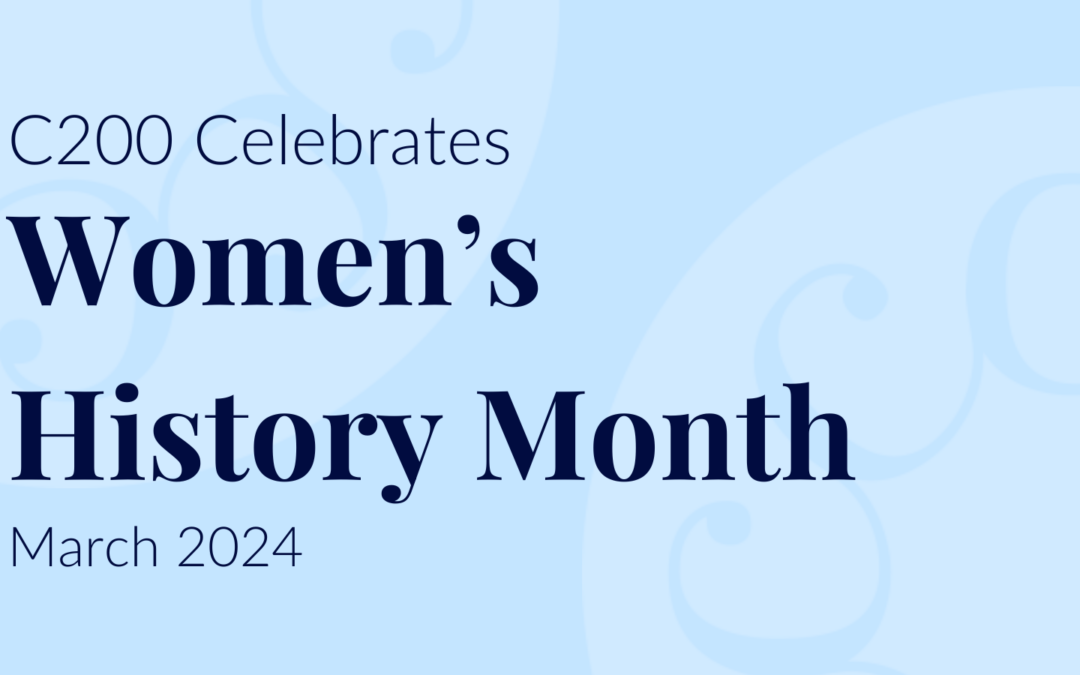
by Eva Glassman | Mar 1, 2024 | Blog, Featured
C200 celebrates women’s history every day of the year, because our organization was founded by groundbreaking women, for groundbreaking women. Every day, our members continue to make history for women in business through their power and influence at the highest heights of success.
Women’s History Month isn’t just about looking into the past. To us, it’s about profoundly impacting and celebrating the advancement of women worldwide by changing the face of business, one woman at a time. Together, we can create a more inclusive and diverse business landscape through inspiring, educating, supporting, and advancing current and future women entrepreneurs and corporate, profit-center leaders.
The numbers don’t lie. Learn more about the statistics that represent the reality of women in business, particularly at the leadership level, and how we can work toward a more equitable working world.
Below is a non-exhaustive list of resources you can utilize to educate yourself about the obstacles all women in business face and how you can advance women in your own life:
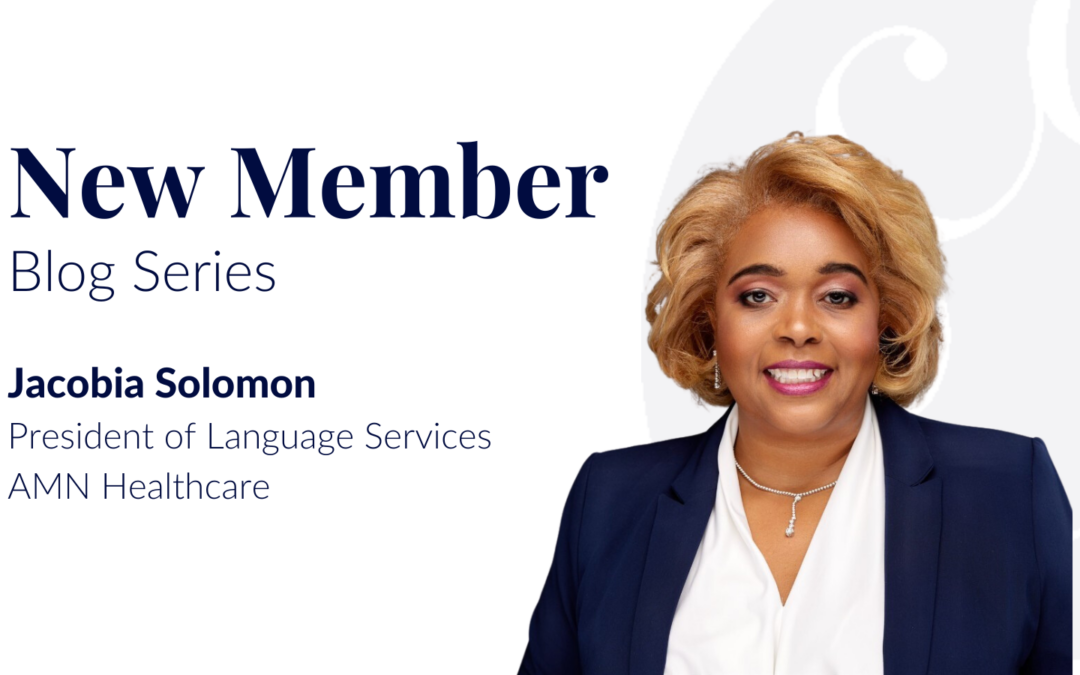
by Eva Glassman | Feb 19, 2024 | Blog, Featured
Jacobia Solomon is the President of Language Services at AMN Healthcare in a division responsible for providing multicultural interpretation and translation services in support of the healthcare journey, specifically for Limited English Proficient and Deaf and Hard of Hearing patients. With an educational background in engineering management, this is Jacobia’s first position in the healthcare industry after a 10+ year career leading engineering organizations. Outside of work, Jacobia loves to spend time with her husband, two sons, and mother; visit comedy clubs; swim; and, as a self-described “adrenaline junkie,” ride fast rollercoasters and cars. Jacobia has been a member of C200 since July 2023.
Eva Glassman: You are the President of Language Services at AMN Healthcare. What’s that like?
Jacobia Solomon: AMN Language Services is a division of AMN Healthcare and the largest provider of interpretation services exclusively supporting the healthcare market. We offer creative solutions that improve communication with a goal to yield better healthcare results within culturally- and linguistically-diverse communities.
The Limited English Proficiency (LEP) and Deaf or Hard of Hearing communities make up about 8.6% of the US population, which is about 27 million individuals that require language services. In 2023, we delivered 271 million minutes and supported 18 million patient encounters. We support the patient through the entire healthcare journey, collaborating with both providers and payers to achieve the ultimate goal of improving healthcare outcomes.
Enabling access and communication is important work when you think about the patient experience and health equity; the number one key determinant of health is access to information, but we often fail to reach the patients that are most at risk. We are in the business of telling engaging, insightful stories. The story we want to tell here is that patients and caregivers deserve the right to understand information regarding the screening, diagnosis of their ailment, the treatment strategy, and the anticipated outcome—which is sometimes life-or-death. Language access is foundational for equity.
EG: What is your day to day like?
JS: Internally, I make sure that we have a clear definition of our vision, and more importantly, how we are working to get there. A big focus for us is ensuring a clear path to value for clients and working with our healthcare partners to improve reliability, efficiency, and generating revenue.
We also focus on expecting future changes, because the healthcare landscape is constantly shifting, which means the needs of our clients and patients are shifting, too. While I am running the business now, I’m also trying to run the business five to ten years from now. Another big focus for us is how we will safely and responsibly use technology advancements such as AI in our business to improve access while aiding clinicians and bring joy back to healthcare.
My team is made up of great leaders who work well at the client experience and executing our strategy, all while adjusting as the landscape for our clients and competitors changes.
EG: I heard that your educational background is in engineering. So, how did you end up in healthcare?
JS: My current role is my first job in healthcare, so I have been in the industry for about a year and a half! I’m a mechanical engineer by trade. My path was partially planned, but I always thought methodically about the skillsets and experiences that I needed to be a great leader.
As a new graduate in engineering, I wasn’t sure where to start my career, so I joined Ford Motor Company’s college graduate program where I rotated through the company and got the chance to figure out what I was good at. I enjoyed my work at Ford and eventually started thinking about how I could grow and become a leader there. Ford supported me in getting my master’s in engineering management, which strengthened my ability to lead technical teams while aligning with business as a whole to ensure a greater impact.
I always thought I could still be who I wanted to be in the workplace, but just when I thought I could do it all, I quickly learned that was not the case. After about 10 years at Ford, they decided to close the facility in Michigan, where I was starting my family with my husband. I needed a support system and had nobody in Michigan, so we moved to Georgia where more of my family lived and could help us raise my kids, especially during the times my husband was deployed in the Army.
While I felt like I was a strong leader, I wanted to understand more about the business world from within a company. The opportunity to join Newell Rubbermaid came up, specifically a role in the Program Management Office. I got to learn other parts of the organization and started thinking about decision-making differently; for example, I started considering beyond the corporate landscape and into the global one, since some of my projects had a global scope.
I left Newell for similar reasons to Ford and pivoted to a smaller company called Mimeo as VP of Engineering. Because it was such a small company, I worked directly with the CEO and oversaw engineering—both product and manufacturing—supply chain, and shipping. I was three-fourths owner of the company and loved having that responsibility.
After Mimeo, I landed at Manitowoc in Texas, where I live today. I was interested in going back to a bigger company to spread my wings more and have a greater leadership scope. It’s funny—I had never been in construction, but I loved the experience of putting on my hardhat and boots and going to the site to see the realization of designs.
Eventually, Manitowoc split into smaller companies, which is why I left and landed at Siemens. They invested in me to get my executive MBA and made me CEO of Siemens Logistics Canada, which I did for two years. I worked the role from Texas because I had just started school and was flying to and from Canada every other week. My experience as CEO of Canada gave me a lot of confidence. I left Siemens because the company went through M&A restructuring, and I realized I didn’t want to be away from my family any longer.
This is when AMN called about my current role; I said, “Are you sure you’re calling the right person? You know I’ve never been in healthcare, right?” [laughs] They have been so supportive and great at giving me the space as President to lead, and they trust that I can deliver. When I think about a bullseye and what hits, this is where my passion and purpose are completely aligned.
Something I learned from my career experience is, as much as we like to think every company or industry is different, you will find more similarities between them and more transferable skills than you think.
EG: Let’s talk a bit about C200! How did you get involved? What drew you to C200?
JS: I found Stephanie Chung on Leadercast and loved her delivery. She lives in Texas like me, so I reached out to her. I said I was interested in connecting with women in Texas who are in similar situations, because the higher you get in business as a woman, especially as a woman of color, the lonelier it is. Sometimes, you just want to walk into a room and look at a person and communicate without any words. That is when Stephanie told me about C200—and the rest is history!
Last October, I went to the C200 Annual Conference in San Diego, and it was exhilarating meeting one powerhouse woman after another. It also made me do a personal inventory of my own accomplishments and feel proud to be among equals and inspired by how they can help me continue to grow. I kept thinking to myself, “If they’ve done it, I shouldn’t be so scared!” and, “They did that? I’ll do it now!”
Now, I am part of C200’s Financial and Investment Committee, which I’m really enjoying because I get to strengthen my relationship and connection to the organization by seeing the way things work and move within it.
EG: Have you had any female mentors throughout your career? What women are inspiring to you?
JS: I didn’t have many female mentors when I first started out, but it was something I sought outside of my workplace. I’ve always joined professional women work groups to learn from others. Early in your career, you think you can conquer the world, but eventually you look around and realize not enough conquering has happened in terms of women leadership.
As I matured in my career, it was important to me that I created not just mentorships, but what I call my “trust circle” of people who will hold up the mirror and tell me the truth (with love!). In that circle of trust, people play different roles, like mentor, sponsor, or supporter. I had both men and women in my circle because it was important for me to have both perspectives, especially since my male counterparts were the ones I was most likely trying to persuade or influence. I believe men and women communicate differently, so I thought it would benefit me to learn from both.
EG: I read that you have a philosophy that goes, “Call others into leadership with you. As you climb, it’s important to lift others with you.” How on theme for C200! How does being a woman in business impact the way you work? What does it mean to you?
JS: Being a woman in business is empowering. It’s all about what you can do to make your space much better than how you inherited it. Women have a natural affinity to go into a place and make it somewhere others want to be. I love seeing women in business because it sparks a feminine creativity in a masculine atmosphere. I think that balance of the feminine and masculine is interesting and exciting from a creative and innovative standpoint.
Women are natural problem solvers because of how we show up in life and positions not asked for; we can make something out of nothing. We’re envelope-pushers; we’ll continue to do it, even if it’s exhausting, because we understand the investment needed to get the result.
When I was younger in my career, I felt as though I always had something to prove; I don’t feel that way at all now. I know now that if there’s no space for me at the table, then I’ll build my own table—I don’t need to be invited. I love the saying, “It’s not about changing who you are, but where you are.” There are many times when you may not be valued, but that’s okay! It’s okay to go somewhere else where you are better valued—I think it’s important for women in business to understand that. When you begin to understand who you are, your worth, and your power, you can have a major impact.
EG: That leads me to my next question, which is: What is your advice to aspiring female business leaders to advance their own careers?
JS: It’s okay to have a career plan, but it’s also okay if that plan doesn’t work out. For me, what worked out was even better than my initial plan. Flexibility is important, because there are certain things about you that you may not give much importance, but someone else may see those things differently in you and give you an opportunity because of it. You don’t want to be clueless about those instances.
Move fearlessly—not without it, but in spite of it. Be courageous in what you do, who you are, and why you do it. Know that change is constant but be courageous in asking for what you want. We don’t ask for what we need all the time because we’re afraid of “No,” but it’s not going to kill us—it just means we didn’t ask the right person, the right way, or at the right time. Maybe it’s because I’m an only child, but “No” doesn’t deter me; it actually drives me!
If I could tell my younger self anything, it would be to protect and honor who you are as you would your loved ones. When you’re younger, it’s easier to take a risk on something new. We have these “guardrails,” real or perceived, that we’re always supposed to stay within and do what’s “right.” Valuing who you are as an individual and your impact when you walk into a room—it means something.
In a society where there is a significant focus on improving your weaknesses, it is equally crucial to handle and capitalize on your strengths. Occasionally, the qualities you excel in can be seen as drawbacks by others in terms of how they perceive and work with you. Moreover, the most intelligent individuals are aware of which flaws to improve upon themselves and which ones to delegate to others. At times, there can be particular aspects that will never become your strong points, and that is perfectly fine! It is advantageous to discover this information earlier and seek individuals whom you can rely on and who excel in those areas more than you do. It is important to invest effort in improving specific weaknesses, but it is also wise to delegate certain other weaknesses to external sources.
EG: Outside of work, what do you like to do for fun?
JS: I love spending time with my husband, two sons, and my mom who’s with us. I like old-school video games like Pac-Man, and I love to read. I love to laugh, so I go to comedy clubs a lot.
I’m a total adrenaline junkie; I love doing really adventurous, silly things that I’m a little scared of inside but do anyway. I love rollercoasters—I’ll go on every ride with you at the theme park. It’s one of my goals this year to skydive, and I’ve also signed up to learn how to be a pilot.
I also love fast cars; while the car definitely has to look good, I’m a horsepower and torque girl—it has to go fast! Even when my kids were little and I had a bigger car, it still had the horsepower and torque I wanted.
I’m also an avid swimmer and try to do that as much as I can. I used to be on a swim team, and I’ve even won a couple of state titles for Florida! Swimming has always been something I’ve really enjoyed; it calms my spirit.
EG: Why C200?
JS: For me, C200 stands for connection, aspiration, and sisterhood. I don’t know if I would have met the amazing women of C200 on my own. It’s a gathering of like-minded individuals that can feed into me as I can pour into them. I’m always looking for authentic and genuine relationships with people that are both similar to and different from me. There are probably things I wouldn’t know or consider if I didn’t have my C200 sisters to learn from.
I envision C200 and my fellow sisters as a multitude of beacons. We’re there to inspire, but also to align and strengthen the “beacons” in all of us into something bigger and brighter. Everyone has their own path, and C200 illuminates all our paths by reminding us that nobody truly does it alone.
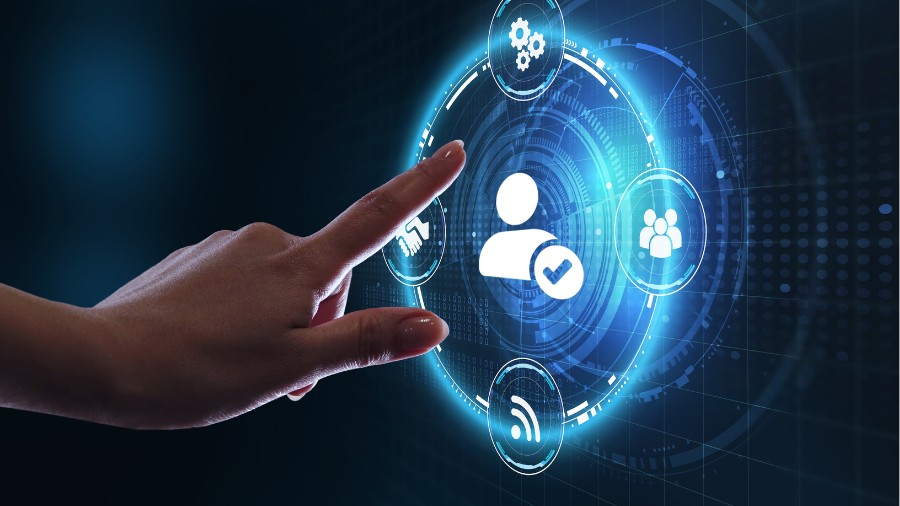
by Eva Glassman | Feb 13, 2024 | Blog, Featured
By Sophia Velastegui, Chief Product Officer, Aptiv | C200 member since 2023
The advent of AI requires a shift in how organizations structure their workforce and cultivate their culture. The future of work is not just about incorporating new technologies, but rethinking how teams collaborate, innovate, and adapt.
In this Forbes article, C200 member Sophia Velastegui provides insights on navigating the impact of AI through a holistic approach that integrates cultural adaptation, strategic planning, and a nuanced understanding of how technology can collaborate with human talent to drive innovation and success.
By building a workforce equipped to handle the complexities of AI, organizations position themselves for successful implementation and optimization of AI technologies, ensuring they remain competitive in an increasingly AI-driven business landscape.
You can read the full article here.
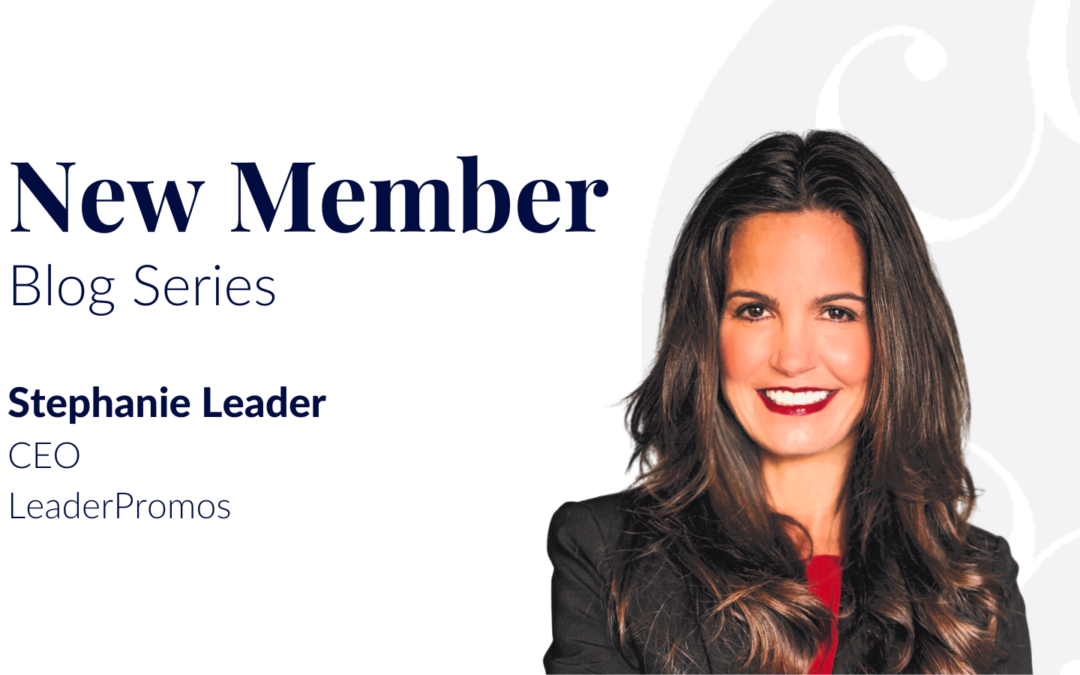
by Eva Glassman | Feb 5, 2024 | Blog, Featured
Stephanie Leader is the CEO and founder of Leader Promotions (dba Leaderpromos), a company that creates and sells purpose-driven branded merchandise and strategically helps their clients deliver their message and reach their goals. With a bachelor’s in political science from The Ohio State University (OSU), Stephanie deferred her admission to law school to become a partner in the company she worked for through college; since then, she has grown and transformed the business into a global corporation, achieving nearly $55 million in revenue in 2023. Outside of work, Stephanie enjoys an active lifestyle and spending time with her family. Stephanie has been a C200 member since November 2023.
Eva Glassman: Can you describe your company and what you do? How did you get started there?
Stephanie Leader: I am the CEO, founder, and visionary of Leader Promotions. We focus on purpose-driven, branded merchandise that delivers results. Our approach within the company is to learn about the initiatives and goals of our clients and provide them with the right merchandise that will best drive their message and give them a good return on their investment. It all starts with asking the right questions.
I started out in this industry when I was 19 years old. To make money and pay my way through school at OSU, I started selling branded merchandise and apparel to the Greek community since OSU had the largest Greek community in North America at the time. I was a political science major and had ambitions to go to law school, but I enjoyed selling merchandise and meeting so many people from different fraternities and sororities.
When I was getting ready to leave for law school in Chicago, my boss at the time asked me if I would consider becoming a partner of the company. My initial reaction was, “Why me?” I realized, once I saw the financials, that I had the highest sales in the company and was leading a lot of our new initiatives already. So, I decided to defer my admission to law school and give this a try. I was supposed to move to Chicago that fall—instead, I became a business owner!
Soon after I became a partner in 1995, my partner got sick with Celiac Disease and left the business. So, there I was with this company, thinking, “Oh my gosh, what am I doing?” The reality quickly set in that I didn’t know anything about running a business. I didn’t know anything about P&L, balance sheets, or budgeting, but over time I started to learn more. I’ve always been persistent and loved being challenged. That year, our revenue was about $400,000; in 2023, we did almost $55 million.
I’m so excited to share that we are newly-certified as a B Corp Company! This was nearly a two-year process and now a passion the entire company is excited about! Leaderpromos is proudly the largest wholly-woman-owned, B Corp company within the industry amongst 28,000 distributors. I was also one of the first people to introduce an e-commerce platform back in 1998. This year, we’ll be launching a new, more curated e-commerce platform that will show people what type of impact they are making with the products they’re purchasing. It’s a lot more of a prescriptive experience that we hope to launch by Q4 of this year!
EG: Your pivot from law school to becoming a partner in a company is so fascinating! What a leap of faith!
SL: I took a small business loan for $20,000 to buy into the business. I don’t even know how or why the banks loaned it to me when I had debt from school. That was my best into the company. I tell this story to my kids—I have a 25-year-old son and my daughter just graduated from Boulder and works in LA—and it’s funny; when my generation was growing up, we didn’t necessarily have a choice as to what we wanted to do. There I was with a political science degree about to go to law school, and never in a million years did I think I was going to be a business owner of a global corporation. It’s really important to keep your eyes and ears open to those opportunities and to the people you meet along the way, because you never know when circumstances can change.
EG: Why do you think it all worked out for you? How did you make that drastic shift in career focus right out of college?
SL: I had to work hard for it. Growing up, my dad had a life-threatening disease, and my parents didn’t have a lot of means. I wanted and needed to support myself and was focused on becoming financially independent. I always treated my work very seriously and cared for the company like it was my own. I gave it 110% every time, even when I didn’t have any ownership. I just wanted to do my best and was always resilient and driven (and maybe a bit stubborn, too). I wanted to buy and do the things I wanted, and that’s what pushed and motivated me when I was young.
EG: Tell me about your journey to C200. How did you hear about it? How did you get involved? What drew you to C200?
SL: I’m very involved in the Women’s Business Enterprise National Council (WBENC) and have a lot of friends through the organization. Recently, a couple of my friends and I were at a WBENC event talking about women’s leadership and how it can be so lonely at the top. That’s when one of my friends, Tara Abraham, said, “You need to join C200. It’s perfect for you.” She told me that it’s a unique organization because at C200, you’re dealing with women who are just like you—women at the top. We’re all dealing with the same issues. It struck me as a good way to develop myself as a leader and gain some strong connections and relationships so that we can help one another.
You don’t really hear a lot about C200—I hear more about other, larger organizations for executive women, but I like that C200 is smaller and more exclusive. A big draw for me was the revenue criteria being as high as it is. It’s really important so that you’re not always the person people go to for advice. At C200, you’re having very good collaborative conversations with women of equal measure about real-life things that only we could understand. While I love mentoring other women and girls, I appreciate that C200 offers more than that. I don’t often take time to think of myself; like other entrepreneurs, it’s not in our nature. C200 allows you to focus on yourself and how you feel. It’s nice to have the company and friendships of other members who are in your place or have been in their careers. Never before have I had conversations with other women that also deal with my issues.
EG: Who are some of the important people in your career who have helped you along the way?
SL: My executive coach helps me with a lot of internal issues both within myself and my organization. I’ve had a couple of male mentors, but not a lot of women in that formalized mentorship setting. In my industry in particular, women didn’t pave the way at all; it was truly a “guy’s guy” industry. That’s the tough thing. When men get to the top, they’re able to get there for all these remarkable reasons, but women aren’t recognized and rewarded in the same way for the same achievements. It’s harder to be a woman leader than it is a man. Getting people’s respect is more difficult, there’s no question.
EG: What does being a “woman in business” mean to you and how do you apply that thinking to what you do and how you lead?
SL: I take a collaborative approach to leadership, which has its benefits and drawbacks. I would never ask anyone to do anything that I wouldn’t do, but at the same time, I need to be the leader and visionary of the company and focus on creating other leaders, which arguably requires getting people out of their comfort zones. I’m also very humbled by where I’m at. I don’t walk around ringing my own bell; my success is just for me. I keep my head down and focus on growth. I want to bring people into the organization, develop them, and create leaders; it’s important to do that as a woman leader.
EG: What is some of the advice you’d give to young women who want to lead and be in your position one day?
SL: One of the most important things with women in business is that there’s always going to be discouraging situations and tough hills to climb. You have to be resilient and understand the way your business works inside and out. You can’t just leave the accounting, for example, to somebody else; you need to know how everything works, or else you can never set the expectations.
Having knowledge of what your brand is, how you want it to be known and perceived by others, is important from day one—and never going against that. If you want to succeed, you’ve got to remember what drove you to do what you’re doing in the first place. People go into business for a variety of reasons, but making sure you always keep what’s real in front of you is key. It’s a very simple idea, but it can be difficult to stay grounded; never let anyone make you into someone you’re not. I always tell people to be authentic, that it’s okay to do things differently and if you don’t create that then you will be left behind.
EG: That’s especially sage advice for women in business. It’s very easy for a woman entering a male-dominated space to assimilate or emulate in order to be heard or respected at the cost of their authenticity as a woman. Carving a space for yourself in your industry and being unwavering in that effort is challenging, but necessary.
SL: It’s hard work, there’s no question about it. When growing up, it wasn’t about who I wanted to work for or what I wanted to do; it was more about, “How am I going to pay my rent?” My daughter, who’s working out in LA, is fortunate that she could set out to work for a specific brand, but for me and those of my generation, we didn’t have those choices. We worked hard, long hours; sometimes you had work-life balance, sometimes you didn’t. You just had to make certain things work. I raised a family; my husband and I set out upfront what was important to us, like family dinners and supporting our kids as athletes and in all the things they did. However, it all meant that when they went to bed, I may not have went to bed right away because there was still work to do.
EG: When you do have free time outside of work, what do you like to do for fun?
SL: Now that my kids are older, I try to see them as much as I can. Like I said earlier, my daughter just went out to LA for work. It’s far from Columbus and hard to accept the reality that she is not just at college but is starting a life so far from home. My son is working with me and learning new ways to measure the business and pave the way for the high-growth company that we are. I am so happy to have him and excited to see what he does for Leader!
I love to travel, hike in the mountains, play pickleball, and be with friends and family—and on the other hand, I also love my mindless TV and not being “on” all the time.
My whole life, everyone has told me I’m outgoing, but I feel like I’m becoming more introverted as I get older. It’s nice to relax watching a movie or get lost in a good book. I value my life away from work and treasure my family and friendships. I want to spend my time and energy with them.
EG: You’ve already touched on this a little bit, but why C200? What are you most excited about as a new member?
SL: I’m still learning a lot about what membership offers and how I should get involved—any pointers from other members are welcome! My goals are to engage with other members and create new relationships with women leaders who are experiencing the same things as I am. I want to grow as a leader and as an individual. I’m really excited to receive some amazing advice from these women! I also want to continue helping others grow and give back through C200’s resources so that rising women leaders have better odds than we did.
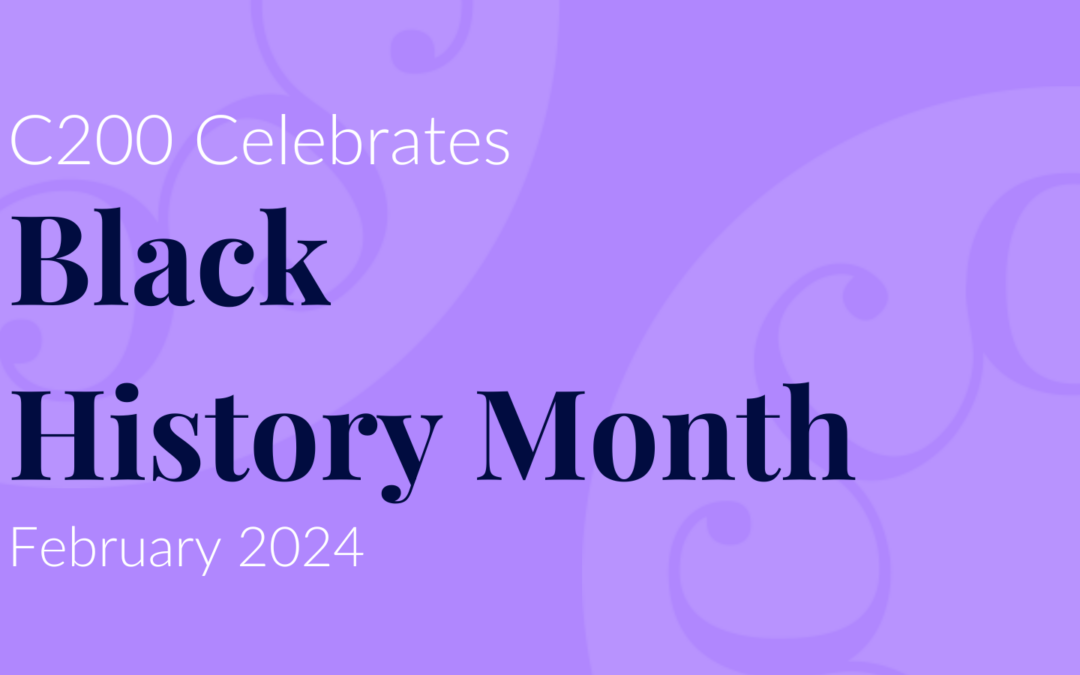
by Eva Glassman | Feb 1, 2024 | Blog, Featured
As we celebrate and acknowledge Black History Month, C200 is committed to taking action to address the long-standing racial inequality in the business world, which affects businesswomen of color the most. The lack of women, especially women of color, in positions of profit and loss (P&L) leadership roles in business is a product of systemic and institutional bias and exclusion. For any odds that women in business have against them, they are exponentially true for women of color—particularly Black women.
This month, C200 will use our platforms to reflect and take action by sharing information and resources that highlight the reality Black women in the workplace, at all levels of business, face daily, so that we can spark important conversations about what it truly means to advance women in business, especially Black women.
We acknowledge that to bring about real progress for women in the business landscape, we must advance all women in that effort. We also acknowledge that this conversation must continue beyond Black History Month, because every businesswoman’s struggle for equality, leadership, and success in the workplace—although each personal and unique—is connected.
Below, please find a non-exhaustive list of studies and reports about women entrepreneurs and corporate executives in the workplace, particularly Black women.

